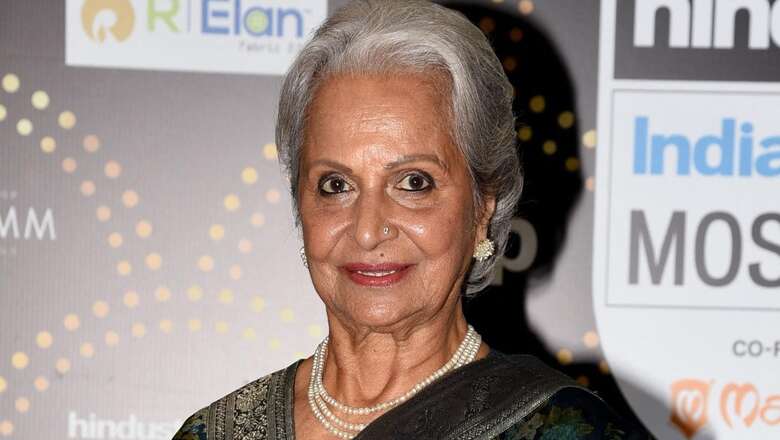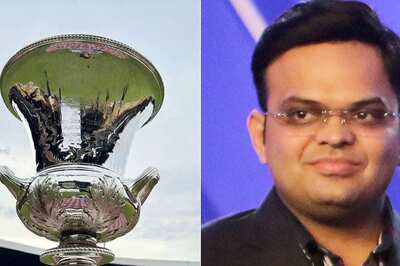
views
On September 26, 2023, the 100th birthday of her favourite co-star Dev Anand, the quintessential beauty and one of India’s greatest female actors ever, often dubbed as the “Queen of Grace”, Waheeda Rehman was announced as the 54th recipient of Dadasaheb Phalke Award. She is only the ninth female recipient (and the seventh female actor) to receive the award, thereby joining the company of Devika Rani (inaugural award winner in 1969), Ruby Meyers alias Sulochana (1973), Kannan Devi (Bengali cinema, 1976), Durga Khote (1983), Asha Parekh (2022) and Rekha (2023). The only other two female recipients are Lata Mangeshkar (1989) and Asha Bhosale (2000).
An award will come when it has to come but make no mistake, it has come to Rehman not any sooner in the day. She considers the award her birthday gift on the 100th birth anniversary of Dev Anand and has dedicated the award to the entire film fraternity.
Happy, Honoured, Humbled
Speaking to an English channel on being nominated for the award, she just uttered three words of profound wisdom — “Happy, Honoured, Humbled.” And she recounted her ultimate feelings with her most popular song that oozes life: ‘Aaj Phir Jeene Ki Tamanna Hain, Aaj Phir Marne Ka Irada Hain.’ She said that her biggest learning in life was never to get disheartened by failures because everyone cannot be one, two and three, there will always be a number four.
One famous statement of Rehman a few years back was “I’ve never feared the future”. Make no mistake, in 65 years of my life, I have seen only one Waheeda Rehman. There is no one like her. In her career spanning more than six decades, she has essayed so many memorable performances of all types that I find it impossible to box her to a type or compare her to any living or dead female actor. Her sheer longevity in an era where female actors had ultra-low shelf life, has been amazing.
It is unsurprising then that Waheeda Rehman in her career, spanning nearly 100 movies, won the Filmfare Best Actress Award for her roles in Guide (1965) and Neel Kamal (1968), Filmfare Lifetime Achievement Award (1994) and the National Film Award for her role as a clanswoman in Reshma and Shera (1971).
The Award
Instituted in 1969, first presented to Devika Rani, the Dadasaheb Phalke Award was introduced by the Government of India to commemorate the contribution of Dhundiraj Govind Phalke (popularly known as Dadasaheb Phalke), to Indian cinema. Phalke directed India’s first full-length feature film, Raja Harishchandra in 1913.
The Dadasaheb Phalke Award is the highest honour in the field of Indian cinema, presented annually by the government, where the recipients are recognised for their ‘outstanding contribution to the growth and development of Indian cinema’. The award comprises a Swarna Kamal (Golden Lotus) medallion, a shawl, and a cash prize of Rs 10 lakh.
The Tribute
The biggest tribute to Rehman winning the Dadasaheb Phalke Award came from none other than Prime Minister Narendra Modi who took to ‘X’ (formerly known as Twitter) with the following utterances.
“Delighted that Waheeda Rehman Ji has been honored with the Dadasaheb Phalke Lifetime Achievement Award. Her journey in Indian cinema has left an indelible mark. A beacon of talent, dedication and grace, she embodies the best of our cinematic heritage. Congratulations to her.”
Delighted that Waheeda Rehman Ji has been honored with the Dadasaheb Phalke Lifetime Achievement Award. Her journey in Indian cinema has left an indelible mark. A beacon of talent, dedication and grace, she embodies the best of our cinematic heritage. Congratulations to her. https://t.co/uuqfXqIW7l— Narendra Modi (@narendramodi) September 26, 2023
Waheeda Rehman No Stranger to Awards
After B Saroja Devi (1969) and Kumari Kamla (1970), Rehman was the third Indian female actor to be conferred with the fourth highest national award — Padma Shri (1972). But she did not stop there. In 2011, she was conferred with the third highest national award — Padma Bhushan. She joined the select list of female actors, Kumari Kamla (1970), B. Saroja Devi (1992) and Zohra Mumtaz Sehgal (2002) who got it before her and Shabana Azmi (2012) and Sharmila Tagore (2013) who received the award after her. Zohra Mumtaz Sehgal is the sole female actor to have been awarded the second-highest award Padma Vibhushan (2010).
Early Life
85-year-old iconic actor and quintessential beauty Waheeda Rehman (born February 3, 1938) was born as the youngest of four daughters to Mohammed Abdur Rehman and Mumtaz Begum. Her dream to be a doctor was shattered by the untimely demise of her father in 1951. Burdened by familial circumstances, and abandoning her doctor dream, she was forced to take to acting in movies that came her way due to her proficiency in dancing as she was formally trained in Bharatnatyam.
The Debut
Though Rehman got her first break as a dancer in the Tamil movie, Alibabavum 40 Thirudargalum, her debut release was the Telugu film Rojulu Marayi (1955), where again she performed the role of a dancer, a role that was given by producer CV Ramakrishna Prasad. Her next movie the same year, Jayasimha, came close on the heels where she played the lead role opposite N. T. Rama Rao.
Bollywood Calling- Beginning with Bad Omen
In 1956, Rehman debuted in Bollywood with a bad omen. In an era when Muhammed Yusuf Khan was called Dilip Kumar, Begum Mumtaz Jehan Dehlavi was known as Madhubala and Mahjabeen Bano was rechristened Meena Kumari, she politely but firmly carried her name on her sleeve and doggedly refused to change it to the something more modern and something sexier.
She entered Bollywood as Waheeda Rehman and steadfastly remained Waheeda Rehman, a name whose literal meaning is ‘the unique one’. She refused to work except on her terms and conditions and never compromised with her principles whether it was on costume or kissing her closest actor friend Dev Anand as part of the movie requirement. It needed abundant courage and extraordinary self-belief to remain who she was in that era and that age.
But there is a famous story of a bullock hitting the car of filmmaker Guru Dutt in Hyderabad and him spotting a young girl who turned out to be the dancer based on whose performance Telugu film Rojulu Marayi (1955) had become a super hit. The accidental luck by chance brought Rehman to Guru Dutt, which culminated in a screen test in Bombay and Guru Dutt signing her on a contract for three years, starting with the film CID where she was cast in the role of a vamp who would have to sing and seduce the hero.
This was an era when once a vampire was always a vampire in the Bollywood lexicon, but the entry of Rehman in her debut film opposite Dev Anand (directed by Raj Khosla and produced by Guru Dutt) in a negative role was electrifying. She not only made the mark with her trademark acting skills, but her evergreen hit song ‘Kahin pe Nigahein Kahin pe Nishana’ became a chart-topper.
‘Hai Apna Dil To Awaara’ – A Fan is Born
I was born in the year 1958, the year Dev Anand and Waheeda Rehman starrer Solva Saal was released, two years after the release of her Bollywood debut CID.
In my early teens, with a movie theatre next to my home, I turned into a Hindi movie addict, primarily to keep my blues (the adolescent depression) away, and the very first movie that I watched in my life in a theatre was Solva Saal. The scene that has stuck with me to date is the song ‘Hai Apna Dil to Awara’ picturised on Dev Anand and Waheeda Rehman in the running train, sung by Hemant Kumar, with the mouth organ played by Rahul Dev Burman.
And I instantly fell in love with the beauty, brain and acting prowess of Rehman who refused to get typecast and broke the mould with her selection of movies, initially under the mentorship of Guru Dutt and soon thereafter under the friendship of her favourite co-star Dev Anand. She is accredited with having worked with all male actors of her era and the next era as well. Also, in terms of directors, she worked with most of them, including the legendary Satyajit Ray in Abhijaan in 1962. The story is Ray himself approached Rehman for the movie.
It will not be an exaggeration to say that beginning with her debut crime thriller CID (1956) to Pyaasa (1957), 12 O’clock (1958), Solva Saal (1958), Kala Bazar (1960), Baat Ek Raat Ki and Bees Saal Baad (1962), Guide (1965), Teesri Kasam (1966) to her more recent, Delhi-6 (2009) and Skater Girl, (2021), I have seen every movie of Waheeda Rehman at least twice and Guide fifty times, to my last counting and am eagerly waiting for her next film.
From Gulabo to Jamila, Radha and Chameli Jaan – An Actor Reimagined
The very second role of Rehman in the movie Pyaasa (1957), where she played the role of Gulabo, a tawaif (prostitute) with a golden heart, proved defining for her budding career and then came Solva Saal with the innocent Laaj and she never looked back.
Kagaz Ke Phool arrived in 1959 where she took her acting many notches higher in the role of a young and fragile aspiring actor Shanti. She majestically weaved her ability to simultaneously bring depth and vulnerability to the character.
Her role of Jamila in her next Muslim social drama, Chaudhvin Ka Chand (1960) was iconic where she played a young girl caught in a love triangle. Her last movie with mentor Guru Dutt was Sahib Bibi Aur Ghulam (1962) where Meena Kumari was in the lead role and Rehman had a supporting role. Though commercially a cropper, the movie turned into an award glosser and Rehman was first nominated for the Filmfare Supporting Actress Award which she eventually did not get.
In between came the thriller Bees Saal Baad (1962, produced and music by Hemant Kumar and directed by Biren Nag), a movie where the young Radha (Rehman), is captivating in the haunting melody ‘Kahin Deep Jale Kahin Dil’ (a song for which both Lata Mangeshkar and Hemant Kumar bagged Filmfare award) and the movie became the biggest grosser of the year. From the perspective of her acting prowess, an equally forceful performance was as Chameli Jaan in Sunil Dutt’s 1963 classic dacoit drama Mujhe Jeene Do, where she played the role of the mule of famous dacoit Jarnail Singh, a movie that proved to be highest earner of 1963.
And the scintillating career of Rehman had taken off and soon would hit the stratosphere. Between 1956 and 2021, she has given so many great performances that every moviegoer will have his/her own favourite out of her ninety-plus. And despite that, I can write treatises on most of her movies, but indubitably, my vote for her two best movies goes to her stellar performances in the two dance dramas Guide and Teesri Kasam. And, for the sake of brevity, I end this piece with these two classics.
Rosie’s – Piya Tose Naina Laage Re
In her most recent conversation, Rehman has confided that ever since Dev Anand first read RK Narayan’s novella Guide (1958) and decided to make the movie, it was her in whom he saw Rosie, even though directors of both Hindi and English versions of the movie were against her being cast as Rosie.
Rehman portrayed the role of iconoclast rebel Rosie at a time when the film industry despised such roles for females. Many wrote her premature obituary over playing the role, including the prophecy that it would probably be her last movie. It was a time of female actors doing love stories or family dramas, depicting women as the ideal.
What made her do Guide was her abiding trust in Dev Anand and her innermost urge to showcase her dancing prowess as a trained Bharatanatyam dancer.
Having seen Guide over 50 times, I have internalised every scene, dialogue and line of the song, but my two favourite dialogues are “Jab matlab se pyar hota hai … toh pyar se matlab nahi rehta” and “These people have faith in me, and I have faith in their faith”. And two favourite songs are ‘Aaj Phir Jeene Ki Tamanna Hai’ and ‘Piya Tose Naina Lage Re’.
The 1965 release Guide has already made its place in cinematic history as a cult classic. Time magazine in its 2010 Bollywood all-time greats, placed Guide at fourth place (just behind Awara, Mother India and Rehman starrer Pyaasa) and ahead of my other favourites Ankur, Sholay, Aandhi and Deewar. In 1967, Guide was nominated for nine Filmfare awards and in an unprecedented manner, it swept the award night winning Best Movie, Best Actor, Best Actress, Best Director, Best Music Director, Best Story, Best Dialogue, And Best Cinematography. Few movies ever dared to reach where Guide went.
Mare Gaye Gulfam – Hiraman’s Hirabai
For me, after Guide, Waheeda Rehman’s greatest performance was in Shailendra produced and Basu Bhattacharya directed musical dance drama Teesri Kasam based on the short story “Mare Gaye Gulfam” written by famous Hindi novelist Phanishwar Nath Renu. The film starring Raj Kapoor and Rehman was set in colonial rural Bihar.
Rehman in the movie essayed the role of Hira Bai, a singer and dancer in a ‘nautanki company’. When Hiraman (Raj Kapoor) transports Hira Bai for 40 km in 30 hours in a covered bullock cart to a village where she’s scheduled to perform in the nautanki, Hiraman the innocent villager gets enchanted by the charm of Hira Bai, the nautanki dancer. Hira Bai manages to make naïve bullock cart driver, villager Hiraman, stay back in the village to watch her dance performances and arranges free passes for him for the nautanki and Hiraman falls in love with her.
The movie ends in a tragedy with teesri kasam, the third vow of Hiraman. As Hiraman attends the nautanki daily to watch Hira Bai perform, he gets visibly upset with the knowledge that other watchers see Hira Bai as a prostitute. Hiraman makes valiant efforts to shield and protect her from society. As the days progress, Hira Bai and Hiraman fall in love and Hiraman picks up fights with locals passing lewd comments on her. Upset, he asks her to leave her profession and to start living a respectable life but that is not the option for Hira Bai. Depressed, Hiraman leaves the fair and retreats to his village. Hira Bai finally meets him one last time to confide her secret that she had been sold and she was not a virgin beauty and then she departs.
Hiraman then takes his third vow (teesri kasam) that he will never again carry a nautanki (company) bai (dancer) in his bullock cart. And the movie ends.
Shailendra had put his life savings to produce Teesri Kasam which bombed at the box office. The film became the ultimate disaster and the proximate cause of his death. He was admitted to the hospital on December 13, 1966, due to a heart attack and died the following day, which also happened to be his friend Raj Kapoor’s birthday.
Post the death of Shailendra on October 10, 1967, at the Vigyan Bhavan in New Delhi at the 14th National Film Award ceremony, Kasam was awarded Best Feature Film of 1966 with a gold medal, Rs 20,000 and a plaque posthumously to producer Shailendra. Teesri Kasam became an instant hit, an epic and all-time classic.
The author is a Multi-Disciplinary Thought Leader and India-based International Impact Consultant. He works as President Advisory Services of Consulting Company, BARSYL He is a compulsive watcher of Bollywood movies. Views expressed in the above piece are personal and solely that of the author. They do not necessarily reflect News18’s views.



















Comments
0 comment